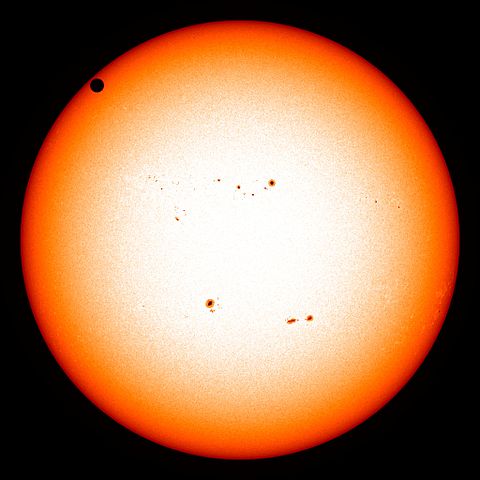Going to Venus in Peace


Every century or so, Venus makes a pair of passes between the Earth and the sun. These two passes, called the “Transits of Venus,” are very predictable. If you were looking at the sun (bad idea) in early June of 2004 or on June 5th/6th of 2012, you would have seen a small black dot appear to move across the star’s surface; that was Venus. If you didn’t, the next one is in December of the year 2117, so, sorry about that; the animated gif above will have to do.
The Transit of Venus, though, is more than a passing curiosity. It’s scientifically important — and also the impetus for a rare example of nations putting aside their differences.
In the late 1600s and early 1700s, the scientific community began to see the Transit as an opportunity for research. In 1716, Edmund Halley — for whom Halley’s comet is named — summarized most of the prevailing theories and suggested that the scientists around the world observe and record data from the black disc moving across the sun during the next Transit, which was to occur in 1761. As different points on the Earth have different longitudes and slightly different distances to the sun, Halley and others believed that they could, collectively, figure out all sorts of neat information — true longitudinal lines (which at the time were best guesses), the distance from the Earth to the sun, and a few other things not necessary to list here. For the 1761 Transit, more than 100 observers in nine different nations tried to collect info. Unfortunately, many were rebuffed by cloudy skies, and the efforts were mostly fruitless.
But the idea was still a good one and thankfully, another chance was soon to come. The 1761 Transit was the first of that century’s pair — another was coming in 1769 — and England wasn’t going to let the opportunity pass. Instead, they decided to send their own observers to the three points — a point in northern Norway; one in Canada; and somewhere in the South Pacific. The first two were pretty easily reached, as Norway is close to England and Canada was under British control at the time. The third one, though, required help from the Navy — and, in an odd way, the French.
Captain James Cook was assigned command of the HMS Endeavour and instructed to go to Tahiti, transporting the observatory team. It was a long trip and it could have a been particularly treacherous one — the Seven Years’ War had just come to a close a few year prior, and the peace between the French and British was an uneasy one. The Endeavour was a ship of exploration with only a limited armament; had it come across the French navy — a likely result — it would have been unmatched and, nearly certainly, been denied safe passage on to Tahiti.
But Cook made it to Tahiti. Why? Because the French cooperated, despite the simmering hostilities. As Wikipedia summarizes, “during Cook’s journey to Tahiti, the French government instructed all its men-of-war not to harm the Endeavour, since it was ‘out on enterprises of service to all mankind.’ With the Venus Transits, astronomers of the eighteenth century illustrated unity in the scientific community.”
Bonus fact: After Tahiti, the Endeavour made its way to Australia, becoming the first European ship to reach the eastern shore of the continent. It needed significant repairs to make the return trip and was later sold to a private merchant named J. Mather. Mather, seeing the opportunity provided by the American Revolution, ended up using the Endeavour (by then renamed the Lord Sandwich 2) as a transport ship, bringing mercenaries over to the Americas. But the Endeavour did not survive the war — a combination of American and French forces sunk it in August of 1778. And then, we lost track of it. Given the historical significance of the vessel, researchers invested a lot of time and effort to locate the Endeavour’s wreck, without a lot of success — until 2016. Just this past May, the Rhode Island Marine Archeology Project announced it had found the remains of the Endeavour, resting at the bottom of Newport Harbor. (The wreck probably won’t be raised, though.)
From the Archives: Venusian Blinds: Another story about the 1761/1769 Transit of Venus.
Related: A really neat, elegant model of the Endeavour. Expensive, though.
